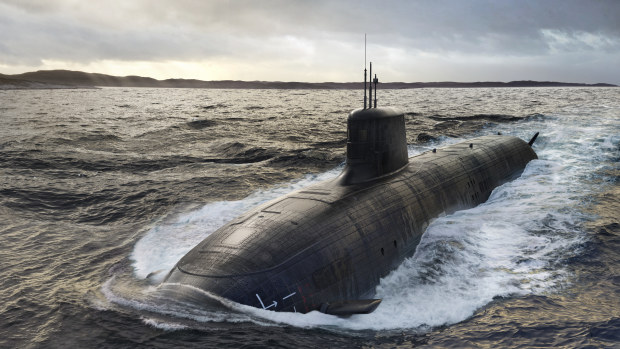Opinion
Defence spending needs to increase 50pc
The military will be skewed towards a small number of potent but expensive submarines, leaving the rest of the navy and air force under-resourced.
Rowan Moffit and Jon StanfordAustralia faces its greatest security threat since 1942 when Japan attacked Darwin and Broome. Bipartisan support for the acquisition of nuclear-powered submarines suggests that the government and opposition appreciate the threat.
But the politicians don’t seem to realise that they are creating a defence force skewed towards a few submarines. Greater investment in high-tech aircraft and other naval capabilities will be required if the strategy is to be effective, which is why we believe defence spending may need to increase by 50 per cent, to 3 per cent of GDP.
Considering the cost of the nuclear submarines and the level of threat, history suggests this is not excessive.

A digitally created image of a nuclear-powered submarine surfacing. ADF
The Albanese government’s policy is known in military terms as a maritime strategy of denial, which requires enemy forces to be kept at a considerable distance from Australia. It necessarily emphasises sea and air power over land forces. For a massive, sparsely populated island nation isolated in oceans a long way from anywhere and shielded by a huge archipelago, this strategic re-think is as sensible as it is long overdue.
The strategy will require a considerable change in the structure of the defence forces, where maintaining the existing balance between the army, navy and air force is an article of faith. Ending this system will be hard. Buying the equipment required may be harder because, based on its performance this century, it is beyond the capability of the Defence Department.
Three new ministers
We cannot blame the people, who are generally hard-working, dedicated officials battling through a labyrinthine bureaucracy and the mire of serial failure. The problems are rooted in the repeated governance and organisational “reforms” the defence forces have endured for 50 years.

Defence Minister Richard Marles would have three junior ministers under the plan. Justin McManus
Technical capabilities stripped from the services over decades of “reform” must be restored. Ministers for the army, navy and air force should be appointed, reporting to the minister for defence. The heads of the army, navy and air force would be accountable to their individual ministers, as they were during World War II and the Vietnam War.
Under the Whitlam government, in an initiative designed and implemented by a powerful mandarin, Sir Arthur Tange, individual service ministries were abolished and brought together under one defence minister.
The Naval Board that had previously controlled the navy, for example, was abolished in February 1976. Full command of the navy vested in the chief of naval staff. An advisory committee was formed, but it had no executive authority and its advice could be ignored.
With the elimination of any constructive competition for resources between the three service departments, flaws soon became apparent. The integrated defence hierarchy could withstand all but direct intervention by a demanding, powerful minister willing to challenge complex professional advice. Changing the core force structure became impossible.
Analyst Paul Dibb, in a letter to then-defence minister Kim Beazley introducing the 1987 strategic review, said he “could obtain no material centrally endorsed by the higher defence structure which explained, for example, the strategic rationale for a 12-destroyer navy, three fighter squadrons, six regular army battalions and an Army Reserve target of 30,000. Most [documents] focus on justifying the present force structure rather than estimating what our strategic circumstances require.”
This remains the situation today. It has generally resulted in asset replacement that is like-for-like within each of the services, including warships, armoured vehicles and aircraft, without much recognition of the changing strategic environment.
For example, the three destroyers of the Adams class, acquired in the 1960s, replaced three Daring-class destroyers and were in turn replaced by three Hobart-class destroyers nearly 50 years later. When the minister offered a fourth Hobart destroyer, which would have been eminently sensible from the perspective of enhancing both industrial and military capability, the navy declined.
It is unrealistic to expect a military hierarchy with this mindset to be able to design and implement the quite different force structure required to address profound changes in Australia’s strategic circumstances. The public version of the Defence Strategic Review fails to acknowledge the government’s adoption of a maritime strategy and appears to prescribe little or no change in the balance between the three services.
Leaving profound differences of view about strategy and acquisitions to be resolved within the bureaucracy rather than around the cabinet table has been a failure. There is a strong case for restoring the executive boards for the three services to advise their service chief and an individual minister under the minister for defence.
Rowan Moffitt is a former fleet commander of the Royal Australian Navy. Jon Stanford is a former division head in the Department of Prime Minister and Cabinet.
Introducing your Newsfeed
Follow the topics, people and companies that matter to you.
Find out moreRead More
Latest In Foreign affairs & security
Fetching latest articles